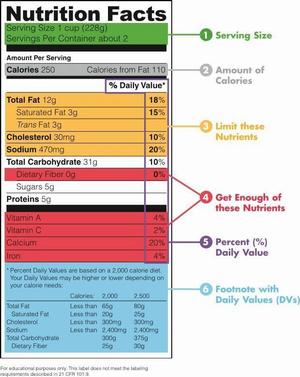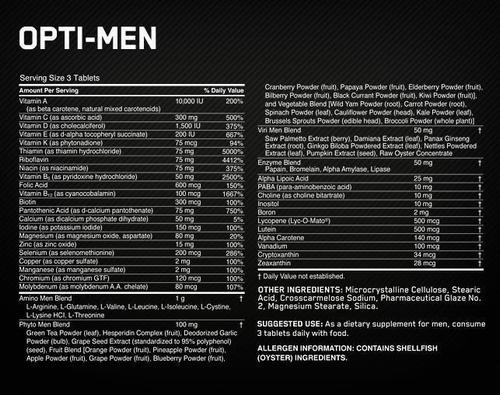Here's how to know and understand food labels

The food label is the panel found on a package of food which contains a variety of information about the nutritional value of the food item. There are many pieces of information which are standard on most food labels, including serving size, the number of calories and grams of fat, included nutrients and a list of ingredients. This information helps people who are trying to restrict their intake of fat, sodium, sugar or other ingredients or those individuals who are trying to get enough of the healthy nutrients such as Calcium or Vitamin C.
The label provides each item with its approximate percentage of the daily value, generally based on a 2000 calorie diet. Not everyone needs 2000 calories a day. Some people need more or less, so be sure to check in with a physician or nutritionist if you're not sure how many calories you should consume each day.
In the local grocery stores, you can usually find many manufacturers of the same type of food, especially the boxed cereal aisle where different brands are competing to show who has the healthiest, lowest sugar cereal on the market. Unfortunately, many manufacturers have forgotten about the consumer and have led them down the deception aisle.
The first thing to be aware of on a food label is the serving size. All the other specifications like calories, fat, sodium, etc. are based on the serving size. Of course, you can get only 1-2 grams of fat in some products if the serving size is the size of a quarter. We know good and well that many of us will eat 3-4 times that amount and increase our fat to about 8-10 grams per serving. Depending on the other ingredients and what the food is, this could be a lot of fat for one serving.
The calories listed are for the serving size only - not the entire package. Of course, some items may say serving size: 1 bar or 2 - 1 pieces. Please be aware that the serving size is very important for you to determine how many calories are in that meal.
Carbohydrates, fats and proteins are listed by the weight in grams. For example, 5 grams of protein in one serving would have 20 calories for that serving.
1 gram of protein = 4 calories
1 gram of carbohydrates = 4 calories
1 gram of fat = 9 calories
The sodium on the food labels is something most people forget to look at. Unfortunately, many packaged products are loaded with sodium. Too much sodium in the diet can lead to water retention and possibly hypertension in some extreme cases. Be aware of a single serving size of sodium with 300 milligrams and above. The RDA (Recommended Daily Allowance) is 2400 milligrams per day. This can be high if you are trying to lose weight or need to watch your blood pressure. One tablespoon of soy sauce has 2000 milligrams alone. Can you imagine how much sodium you take in during one dinner out for Chinese food?
Ingredients on the food label are listed in order of their weight per serving. For example, an item with high-fructose corn syrup as the first ingredient is going to be a high-sugar, high carbohydrate food. You would then want to look at the sugar content on the label and make sure the serving is less than 20 grams. If it is above that, be careful - sugar turns into fat if not used.
The fat content of food is usually broken down into total fat and saturated fat. The saturated fat, the fat from animal products, is what you need to stay away from. Good sources of fats are olive oil, peanut butter, avocados and almonds (not almond butter).

Nutritional labels weren't intended to be hard to understand. They were created to help consumers shop for healthier food.
Understanding Serving Sizes
The first section you'll see on a food label is the serving size and the number of servings in the package. That might seem straightforward, but pay close attention to this section because the rest of the information on the nutrition label is based on the specific serving size listed.
Serving sizes on nutrition labels are listed as standard measurements followed by the metric equivalent, so they should be easy to understand. However, what you may consider a reasonable serving might not be what the manufacturer had in mind when creating the label. If the serving size listed is one cup and you consumed two cups, you'll need to do a little math and double the rest of the information listed on the label.
How to Check the Calories
Below the serving size information, you'll find a section listing the number of calories per serving and how many of those calories come from fat. Ultimately, calories equal energy. As you probably already know, it is not a good idea to consume more energy in a day than you will use.
Understanding Nutrients and Daily Values
The nutrients portion of a label is divided into two sections, usually separated by a thick, black line. Nutrients that should be limited are listed first like fat, cholesterol and sodium. Below those, you will find a list of key nutrients like vitamins, calcium and iron that you should try to get enough of in your diet.
When you look at this section of a nutritional label you will also see two columns of information. The left side lists the name of the nutrient and how much of that nutrient is in a serving of the food. On the right side is the percentage of the Recommended Daily Value (RDV). The RDV percentage represents how much of your daily quota a serving of that food will fulfill.
Nutrients Without a Recommended Daily Value
You might notice a few nutrients on food labels that don't include a recommended daily value percentage: trans fat and sugars, and sometimes protein. Not all fats are created equal, but generally, nutritionists recommend keeping your daily consumption of both trans fat and saturated fat to a minimum, plus minimizing sugar intake.
A recommended daily value for protein is only required on labels if the manufacturer claims the food is a good source of protein or if the product is intended for infants or children under four years old.
Are You Getting Enough Vitamins and Nutrients?
If you're not getting enough of the vitamins and nutrients your body needs from your food choices, you can help cover your nutritional bases with a complete multivitamin like Opti-Men or Opti-Women.

In addition to their ingredients, supplements have a Supplements Facts label, which includes the amount per serving and the daily value percentage to help you achieve your recommended daily value.
Keeping an eye on nutritional labels will help you know when you are getting the right balance of nutrients recommended for you by a physician or a nutritionist for optimal health.
In conclusion, do not be a victim of all the manufacturer hype out there!! All the low-fat, low-sodium and fat-free products are causing consumers to add unwanted pounds to their bodies. Just because it says "FAT-FREE" does not mean that it is good for you. You still have to burn more calories than you take in to lose body fat.